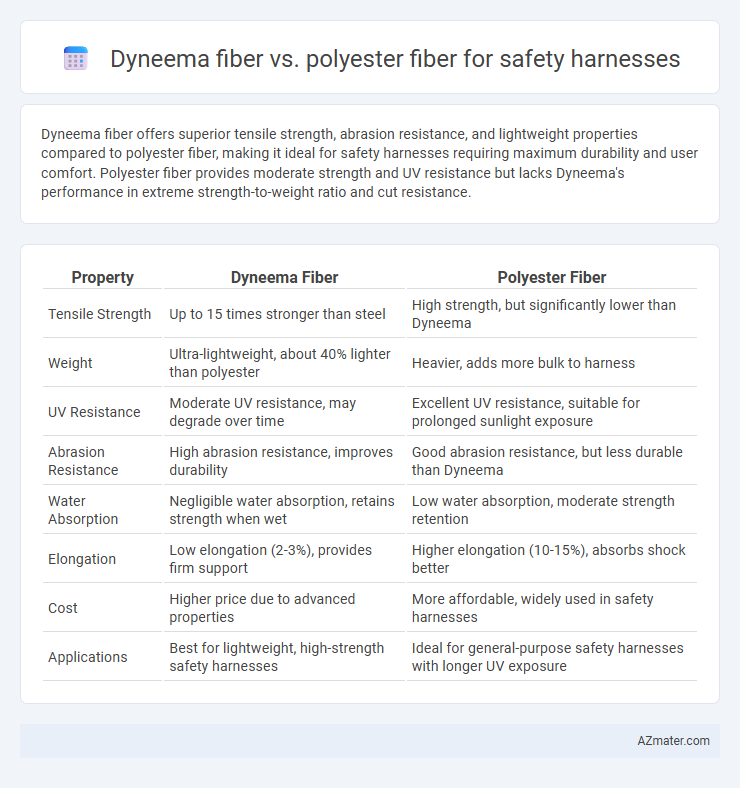Dyneema fiber offers superior tensile strength, abrasion resistance, and lightweight properties compared to polyester fiber, making it ideal for safety harnesses requiring maximum durability and user comfort. Polyester fiber provides moderate strength and UV resistance but lacks Dyneema's performance in extreme strength-to-weight ratio and cut resistance.
Table of Comparison
| Property | Dyneema Fiber | Polyester Fiber |
|---|---|---|
| Tensile Strength | Up to 15 times stronger than steel | High strength, but significantly lower than Dyneema |
| Weight | Ultra-lightweight, about 40% lighter than polyester | Heavier, adds more bulk to harness |
| UV Resistance | Moderate UV resistance, may degrade over time | Excellent UV resistance, suitable for prolonged sunlight exposure |
| Abrasion Resistance | High abrasion resistance, improves durability | Good abrasion resistance, but less durable than Dyneema |
| Water Absorption | Negligible water absorption, retains strength when wet | Low water absorption, moderate strength retention |
| Elongation | Low elongation (2-3%), provides firm support | Higher elongation (10-15%), absorbs shock better |
| Cost | Higher price due to advanced properties | More affordable, widely used in safety harnesses |
| Applications | Best for lightweight, high-strength safety harnesses | Ideal for general-purpose safety harnesses with longer UV exposure |
Introduction to Safety Harness Fibers
Dyneema fiber offers exceptional tensile strength and lightweight properties, making it ideal for safety harnesses requiring maximum durability and comfort. Polyester fiber provides good abrasion resistance and UV stability, ensuring reliable performance under varied environmental conditions. Comparing these materials highlights the importance of fiber choice in enhancing safety harness longevity and wearer protection.
What is Dyneema Fiber?
Dyneema fiber is an ultra-high-molecular-weight polyethylene (UHMWPE) known for its exceptional strength-to-weight ratio, making it significantly stronger than steel on a weight-for-weight basis. It offers superior cut resistance, high tensile strength, and excellent durability, essential for safety harness applications where maximum protection and lightweight comfort are critical. Compared to polyester fiber, Dyneema provides enhanced abrasion resistance and lower stretch, improving harness performance under dynamic loads.
What is Polyester Fiber?
Polyester fiber, a synthetic polymer derived from petroleum, is widely used in safety harnesses due to its high tensile strength, abrasion resistance, and durability. Compared to Dyneema fiber, polyester offers better UV resistance and maintains its integrity under prolonged exposure to sunlight, making it suitable for outdoor applications. While Dyneema fiber provides superior strength-to-weight ratio and cut resistance, polyester fiber remains a cost-effective, reliable choice for safety harnesses requiring moderate strength and excellent environmental resistance.
Key Mechanical Properties Comparison
Dyneema fiber offers superior tensile strength, boasting up to 15 times the strength of steel by weight, which surpasses polyester fiber's strength by a significant margin. Its exceptional abrasion resistance and low stretch enhance safety harness performance by maintaining integrity under dynamic loads, whereas polyester exhibits higher elongation and moderate abrasion resistance. Dyneema also provides better fatigue resistance and lighter weight, making it an optimal choice for high-performance safety harness applications.
Strength and Durability Analysis
Dyneema fiber exhibits exceptional tensile strength, often surpassing polyester by up to 15 times, making it ideal for high-performance safety harnesses requiring maximum load-bearing capacity. Its superior abrasion resistance and low moisture absorption contribute to enhanced durability, maintaining structural integrity even in harsh environmental conditions. In contrast, polyester offers moderate strength with good UV resistance but tends to degrade faster under continuous heavy stress and exposure, impacting long-term safety and reliability.
Weight and Flexibility Differences
Dyneema fiber offers significantly lower weight compared to polyester fiber, making it ideal for safety harnesses where minimizing bulk is crucial. Its superior flexibility enhances wearer comfort and mobility, allowing for easier movement during extended use. Polyester fiber, while durable, is heavier and less flexible, potentially causing fatigue and restricting motion in demanding environments.
Resistance to UV, Chemicals, and Abrasion
Dyneema fiber offers superior resistance to UV radiation, chemicals, and abrasion compared to polyester fiber, making it ideal for safety harnesses exposed to harsh environments. Its ultra-high molecular weight polyethylene composition provides exceptional durability and longevity under prolonged sunlight and chemical exposure. Polyester fibers, while strong and versatile, degrade faster under UV exposure and show less chemical resistance and abrasion durability than Dyneema.
Cost and Availability Factors
Dyneema fiber offers superior strength-to-weight ratio and durability for safety harnesses but comes at a higher cost compared to polyester fiber, which is more budget-friendly and widely available. Polyester fibers dominate the market due to their consistent supply chain and affordability, making them the preferred choice for large-scale production. Cost sensitivity and easy accessibility make polyester ideal for standard safety harness applications, while Dyneema is reserved for high-performance scenarios requiring enhanced safety and longevity.
Practical Applications in Safety Harnesses
Dyneema fiber offers exceptional strength-to-weight ratio and superior cut resistance, making it ideal for high-performance safety harnesses used in construction, climbing, and rescue operations where maximum durability and reduced weight enhance user safety and comfort. Polyester fiber, known for its excellent UV resistance and cost-effectiveness, is widely applied in safety harnesses for general industrial use, providing reliable abrasion resistance and maintaining strength in outdoor environments. Practical application choices depend on the balance between Dyneema's advanced performance attributes for critical safety tasks versus polyester's affordability and weather resistance for everyday industrial safety gear.
Choosing the Right Fiber: Dyneema vs Polyester
Dyneema fiber offers exceptional strength-to-weight ratio, making safety harnesses lighter yet stronger compared to polyester fiber, which is known for its durability and UV resistance. Choosing Dyneema enhances performance in high-load, weight-sensitive applications, while polyester provides better abrasion resistance and longevity in harsh environmental conditions. For optimal safety and durability, consider the specific demands of the work environment, including load requirements and exposure to sunlight, when selecting between Dyneema and polyester fibers.

Infographic: Dyneema fiber vs Polyester fiber for Safety harness
 azmater.com
azmater.com